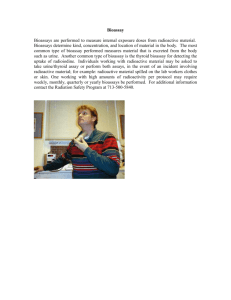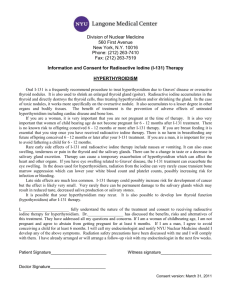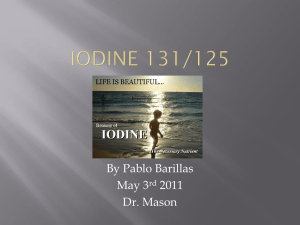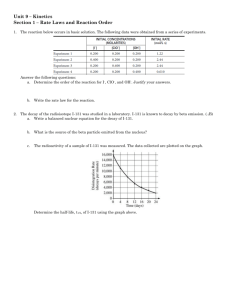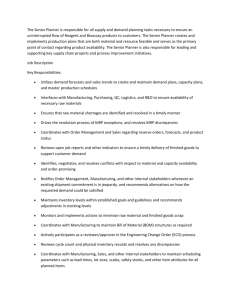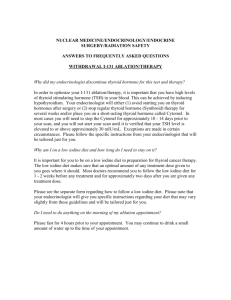Reguide5_9
advertisement
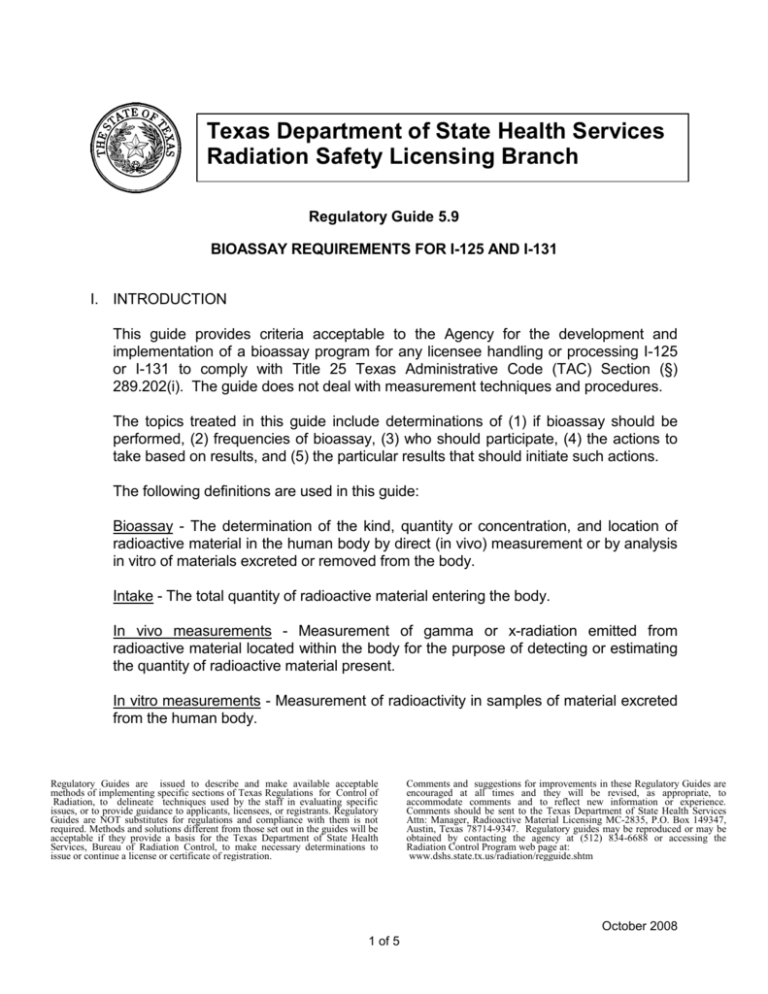
Texas Department of State Health Services Radiation Safety Licensing Branch Regulatory Guide 5.9 BIOASSAY REQUIREMENTS FOR I-125 AND I-131 I. INTRODUCTION This guide provides criteria acceptable to the Agency for the development and implementation of a bioassay program for any licensee handling or processing I-125 or I-131 to comply with Title 25 Texas Administrative Code (TAC) Section (§) 289.202(i). The guide does not deal with measurement techniques and procedures. The topics treated in this guide include determinations of (1) if bioassay should be performed, (2) frequencies of bioassay, (3) who should participate, (4) the actions to take based on results, and (5) the particular results that should initiate such actions. The following definitions are used in this guide: Bioassay - The determination of the kind, quantity or concentration, and location of radioactive material in the human body by direct (in vivo) measurement or by analysis in vitro of materials excreted or removed from the body. Intake - The total quantity of radioactive material entering the body. In vivo measurements - Measurement of gamma or x-radiation emitted from radioactive material located within the body for the purpose of detecting or estimating the quantity of radioactive material present. In vitro measurements - Measurement of radioactivity in samples of material excreted from the human body. Regulatory Guides are issued to describe and make available acceptable methods of implementing specific sections of Texas Regulations for Control of Radiation, to delineate techniques used by the staff in evaluating specific issues, or to provide guidance to applicants, licensees, or registrants. Regulatory Guides are NOT substitutes for regulations and compliance with them is not required. Methods and solutions different from those set out in the guides will be acceptable if they provide a basis for the Texas Department of State Health Services, Bureau of Radiation Control, to make necessary determinations to issue or continue a license or certificate of registration. Comments and suggestions for improvements in these Regulatory Guides are encouraged at all times and they will be revised, as appropriate, to accommodate comments and to reflect new information or experience. Comments should be sent to the Texas Department of State Health Services Attn: Manager, Radioactive Material Licensing MC-2835, P.O. Box 149347, Austin, Texas 78714-9347. Regulatory guides may be reproduced or may be obtained by contacting the agency at (512) 834-6688 or accessing the Radiation Control Program web page at: www.dshs.state.tx.us/radiation/regguide.shtm October 2008 1 of 5 II. CONDITIONS UNDER WHICH BIOASSAYS ARE NECESSARY 1. Periodic bioassays are necessary when an individual handles in open form unsealed quantities shown in Table 1 of this guide. The quantities shown in Table 1 apply to both the quantity handled at any one time or total amount of activity handled by an employee over any three (3) month period. 2. Special bioassay measurements should be performed to verify the effectiveness of respiratory protection devices and protective clothing. If an individual wearing a respiratory protective device or protective clothing is subjected to a concentration of I-125 or I-131 in air such that his or her intake with no protection would have exceeded the limits specified in 25 TAC §289.202(f)1, bioassays shall be performed to determine the resulting actual I-125 or I-131 intake. III. PERSONS TO RECEIVE BIOASSAYS All workers likely to receive greater than 10% of their annual radiation exposure annual limit from handling radioactive iodine shall receive bioassays as specified in 25 TAC §289.202(q)(2). IV. TYPES OF BIOASSAY THAT SHOULD BE PERFORMED 1. Baseline (pre-employment or pre-operational) - Prior to beginning work with radioactive iodine. This is to assure the worker is not already contaminated internally. 2. Routine - At the frequency specified below. 3. Emergency - As soon as possible after any incident that might cause thyroid uptakes to be excessive. [See 25 TAC §289.202(xx) for examples of situations which trigger reporting.] 4. Post-operational and with Separation Physical - A bioassay should be performed within two (2) weeks of the last possible exposure to I-125 or I-131 when operations are being discontinued or when the worker is terminating activities with potential exposure to these radionuclides. 1 Multiplying the concentrations given in 25 TAC §289.202(ggg)(2)(F), Table I, Column 3, 3 x 10-8 µCi/ml for I125 and 2 x 10-8 µCi/ml for I-131, by 6.3 x 108 ml gives the corresponding quarterly intake of the respective iodines by inhalation. These quarterly intakes would be about 18.9 µCi for I-125 and 12.6 µCi for I-131, which would give a thyroid dose commitment of about 12.5 rem to a 20-gram thyroid integrated over all future time using effective half-lives of 41.8 days for I-125 and 7.6 days for I-131 and using a quality factor (QF) of 1.7 to calculate effective disintegration energy in the case of I-125. (This QF of 1.7 is used for conservatism, even though the International Commission on Radiological Protection (1969) and the National Council on Radiation Protection (1971) have published as QF of 1, because some calculations in more recent scientific literature have suggested the use of QF values higher than 1 for electron or beta energies of 0.03 MeV or less.) October 2008 2 of 5 5. Diagnostic - Follow-up bioassay should be performed within two (2) weeks of any measurements exceeding levels given as action points in Section VI, in order to confirm the initial results and, in the case of a single intake, to allow an estimate of the effective half-life of radioiodine in the thyroid. V. FREQUENCY 1. Initial Routine - Initially a bioassay sample or measurement should be obtained between 12 and 72 hours following entry of an individual into an area where bioassays are required and every two (2) weeks thereafter. When work with radioactive iodine is on an infrequent basis (less frequently than every two (2) weeks), bioassay should be performed within ten (10) days of the end of the work period during which radioactive iodine was handled (but not sooner than six (6) hours unless emergency actions to obtain an early prognosis and thyroid blocking treatment are appropriate2). 2. After Three (3) Months - When a periodic measurement frequency has been selected, it may be changed to quarterly provided after three (3) months, all the following conditions are met: (a) The average thyroid burden for each individual working in a given area was less than 0.24 µCi of I-125, or less than 0.20 µCi of I-131, during the initial three month period3; and (b) The working conditions have remained constant with regard to airborne concentrations and/or amount of iodine handled. 3. After Use of Respiratory Protection Devices - Between 6 and 72 hours after respiratory protective devices, suits, hoods, or gloves are used to limit exposure. For individuals placed on a quarterly schedule, sampling should be randomly distributed over the quarter but should be done within one week after a procedure involving the handling of I-125 or I-131. This will provide a more representative assessment of exposure conditions. If levels are found to exceed 2.0 µCi of I-125 or 1.67 µCi of I-131 then bi-weekly assays must be restarted4. VI. ACTION POINTS AND CORRESPONDING ACTIONS 2 NCRP Report No. 55, "Protection of the Thyroid Gland in the Event of Releases of Radio-iodine", National Council on Radiation Protection and Measurements, Washington, D.C., August 1, 1977, p.21. 3 Based upon ICRP Publication 54, 1987. Recording Level = 0.1 ALI/N N = Number of monitoring periods in a year (i.e., 24) 4 Based upon ICRP Publication 54, 1987 Recording Level = 0.033 ALI (Monitoring each individual only once per quarter) October 2008 3 of 5 1. When collecting bioassay samples every two weeks, whenever the thyroid burden at the time of measurement exceeds 0.75 µCi of I-125 or 0.63 µCi of I-131, the following actions should be taken5: (a) An investigation of the operations involved, including air and other in-plant surveys should be carried out to determine the causes of exposure and to evaluate the potential for further exposures. (b) If the investigation indicates that further work in the area might result in exposure of a worker to concentrations that are excessive, the licensee should restrict the worker from further exposure until the source of exposure is discovered and corrected. (c) Corrective actions that will eliminate or lower the potential for further exposures should be implemented. (d) A repeat bioassay should be taken within two (2) weeks of the previous measurement and should be evaluated within 24 hours after measurement in order to confirm the presence of internal radioiodine and to obtain an estimate of its effective half-life for use in estimating dose commitment. (e) Reports or notification must be provided as required by 25 TAC §§289.202(nn) and 202(rr), 202(vv) and 202(yy). 2. When collecting bioassay samples every two weeks, if the thyroid burden at any time exceeds 2.5 µCi of I-125 or 2.0 µCi of I-131, the following actions should be taken6: (a) Carry out all steps described above. (b) As soon as possible, refer the case to appropriate medical consultation for recommendations regarding therapeutic procedures that may be carried out to accelerate removal of radioactive iodine from the body. This should be done within two to three (2-3) hours after exposure when the time of exposure is known so that any prescribed thyroid blocking agent would be effective. (c) Carry out repeated measurements at approximately one (1) week intervals at least until the thyroid burden is less than 0.24 µCi of I-125 or 0.20 µCi of I-131. 5 Based upon ICRP Publication 54, 1987 Investigational Level = 0.3 ALI/N N = Number of monitoring periods in a year (i.e., 24) 6 Based upon ICRP Publication 54, 1987 Interventional Level = ALI/N N = Number of monitoring periods in a year (i.e., 24) October 2008 4 of 5 If there is a possibility of longer term retention of I-125 or I-131, continue measurements as long as necessary to ensure that appreciable exposures do not go undetected. Table 1 ACTIVITY LEVELS ABOVE WHICH BIOASSAY FOR I-125 OR I-131 IS NECESSARY Total Activity Handled in Unsealed Form Over a Three (3) Month Period Making Bioassay Necessary7 Types of Operations Processes in open room or bench, with possible escape of iodine from process vessels. Processes with possible escape of iodine carried out within a fume hood of adequate design, face velocity, and performance reliability. Processes carried out within glove boxes, ordinarily closed, but with possible release of iodine from process and occasional exposure to contaminated box and box leakage. Volatile or Dispersible 1 mCi Bound to Non-volatile Agent 10 mCi 10 mCi 100 mCi 100 mCi 1000 mCi 7 Quantities may be considered the cumulative amount in a process being handled by a worker during a three month period; e.g., the total quantity introduced into a chemical or physical process over a three month period, or on one or more occasions in that period, by opening stock reagent containers from which radioactive iodine may escape. Quantities in the right hand column may be used when it can be shown that the activity in the process is always chemically bound and processed in such a manner that I-125 or I-131 will remain in non-volatile form or diluted to concentrations less than 0.1 mCi/mg of non-volatile agent. Capsules (such as gelatin capsules given to patients for diagnostic tests) may be considered to contain the radioiodine in non-free form, and bioassay would not be necessary unless a capsule were inadvertently opened (e.g., dropped and crushed). Certain compounds, however, where radioiodine is normally bound are known to release radioiodine when the material is in the process, and the left hand column may then be applicable. In those laboratories working only with I-125 in radioimmunoassay (RIA) kits, the quantities of I-125 are very small and in less volatile forms; bioassay requirements in cases where RIA kits are being used, therefore, may be judged from the right hand column. In field operations where reagent containers are opened outdoors for simple operations such as pouring liquid solutions, the above table does not apply; bioassay should be performed whenever an individual employee handles in open form (e.g., an open bottle or container) more than 50 mCi at any one time. Operations involving the routine use of I-125 or I-131 in an open room or bench should be discouraged. Whenever practicable, sealed bottles or containers holding more than 0.1 mCi of I-125 or I-131 should be opened, at least initially, within hoods having adequate face velocities of 0.5 m/sec or more. October 2008 5 of 5
